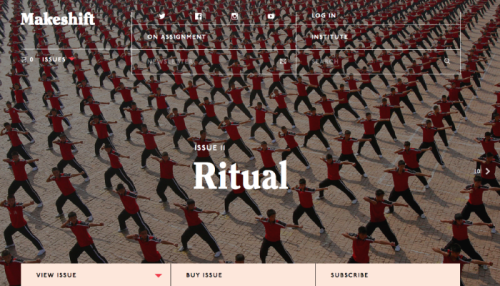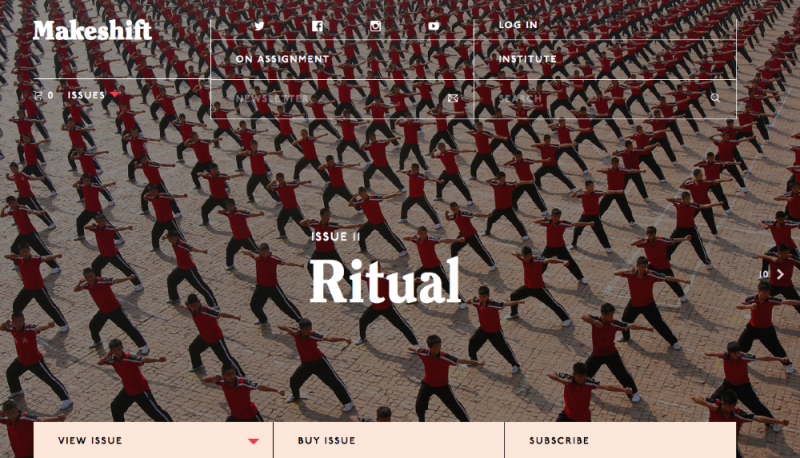Makeshift — A field guide to hidden creativity has a new issue out, all about ritual. Some of the articles are online. They gather together examples of rituals, especially as used to be more creative & engaging. Thanks to David Jenka for passing this along to us!

They inventory their community’s creativity rituals.
From a clear workspace to a clear state of mind, every creative professional has different ways of achieving creative flow—that know-it-when-you-feel-it sense of being fully immersed in your work and producing your best results. Dr. Mihaly Csikszentmihalyi, who coined the phrase, says it happens when people are challenged intellectually in areas in which they are highly skilled. But it takes more than an interesting problem to solve; we must prepare.
They look at how everyday objects have rituals embedded in them.
In her ongoing project, “Software”, the San Francisco-based artist [Binta Ayofemi] identifies open-source ‘code’ in the everyday—from Shaker-style furniture to Soul Train music—and explores how, through variation and repetition, they can rewire how we process and relate to our daily experiences in the world.
They profile Spanish street performers’ rituals.
The practitioners fake steel, stone, or levitation, and the long cast of characters attracts the fascination—and pocket change—of the many tourists and residents crossing the heart of the old capital. Each performer has his or her own routine and style. Frozen most of the time, but able to move in quick bursts, they perform original ideas on statues that have been manufactured in secret home studios from their own designs or with the support of more practiced designers like Fran. Raw materials are very basic: cardboard, foam, theater makeup, and some metal bars.
…
FRIEZE YOURSELF
Becoming a living statue requires discipline and creativity. Here are some tips from a pro:
- Develop a likeable character who won’t be mocked.
- Create a costume and apply makeup. Light or metallic colors and water-based makeup work best.
- Make sure your eyes stand out, and cover your hair to keep a natural look.
- Choose a thank-you action: a small gesture or a giveaway for when people tip.
- When performing, stay relaxed and select positions that require minimal effort to hold.
- Use slow and controlled movements to shift position. Breathe deeply and slowly.
- Try not to freak people out. Unless they deserve it.
- Protect your turf. Don’t let other performers steal your business.
And they talk to an artist who goes on creative benders, spending 72 hours at a time in inventing mode.
The 24-year-old’s mad scientist routine began in 2011, when, after Kenyan technical universities rejected him over poor grades, Peter thought his dream of becoming a robotics engineer was shattered. He’d grown up watching his father, a mechanical engineer, fix electronic gadgets and bring materials home to work on hobby projects, and he aspired to do the same. But after Peter saw the first installment of the Transformers movies and read an inspiring Bible verse (Matthew 7:7) encouraging him to “ask, seek, and knock for answers”, he had an idea: he could teach himself to build robots, starting with a 4×4 remote-controlled car.
“I wanted to create something that would cause a ‘wow’ factor when someone sees it,” he recalls.For six months, he carved out a personalized routine. He’d work nearly every hour of the day, using simple tools—a hammer, hacksaw, snip, vice, geometric compass, and pliers—and plenty of trial and error. With the 2,000 shillings (USD 23) fronted by his parents, he bought spare parts of motors and cables from stores selling electronic scraps.
…
When Peter got frustrated in moments like these, he would ride his bicycle to a nearby forest and lie on the grass, face up to the clouds, and empty his mind. Or he’d pedal to a garage and study the mechanics at work or visit a road construction site to watch the forklifts and grinders. Most of the time, he returned with fresh ideas for his car.
Then it was back to the drawing board, working for 72-hour periods with only an occasional nap or bike break. R&B and hip-hop music pumped through the speakers that hang in each corner of his bedroom. “Provided that I have music in the background, I am good,” he says. “It has to deliver the kind of [buzz] I want.”Eventually, when his body would cave in and his concentration waned, he’d sleep for a six-hour stretch. He went days without showering and finally stopped to wash when he couldn’t stand his own smell. The only time Peter was aware of the hour was when his mother popped in with food, which he wolfed down while he worked.
